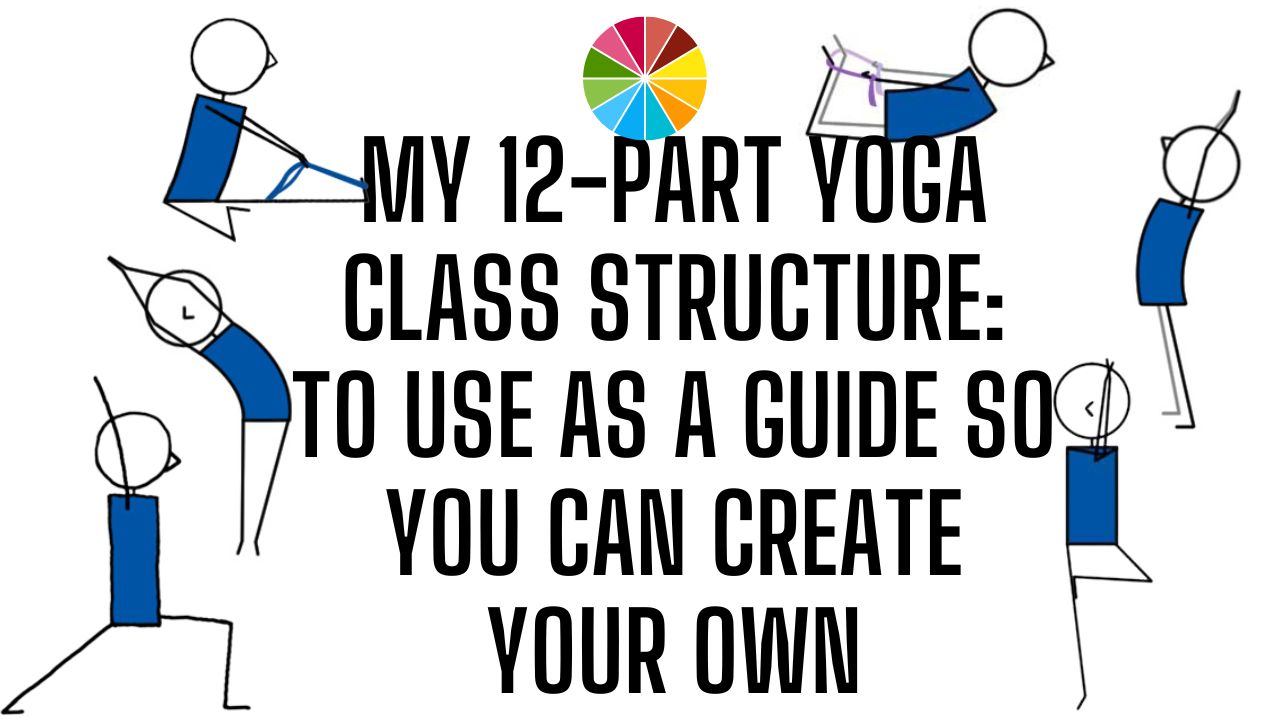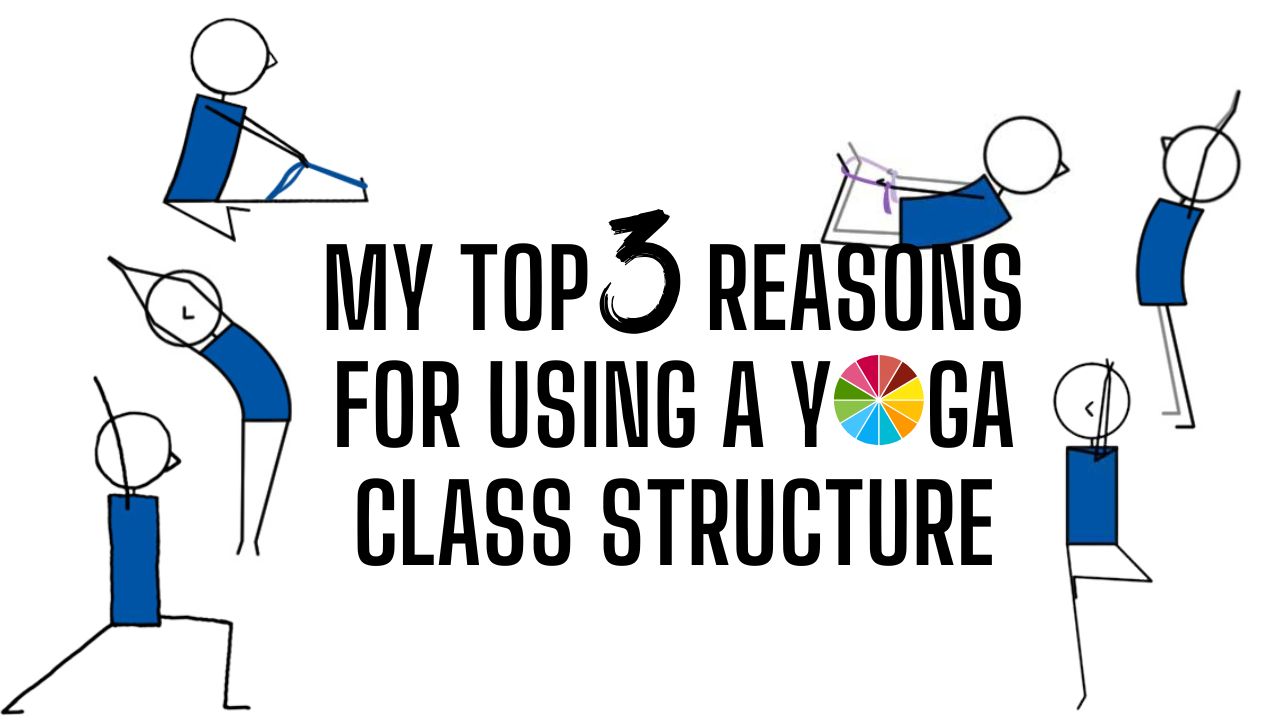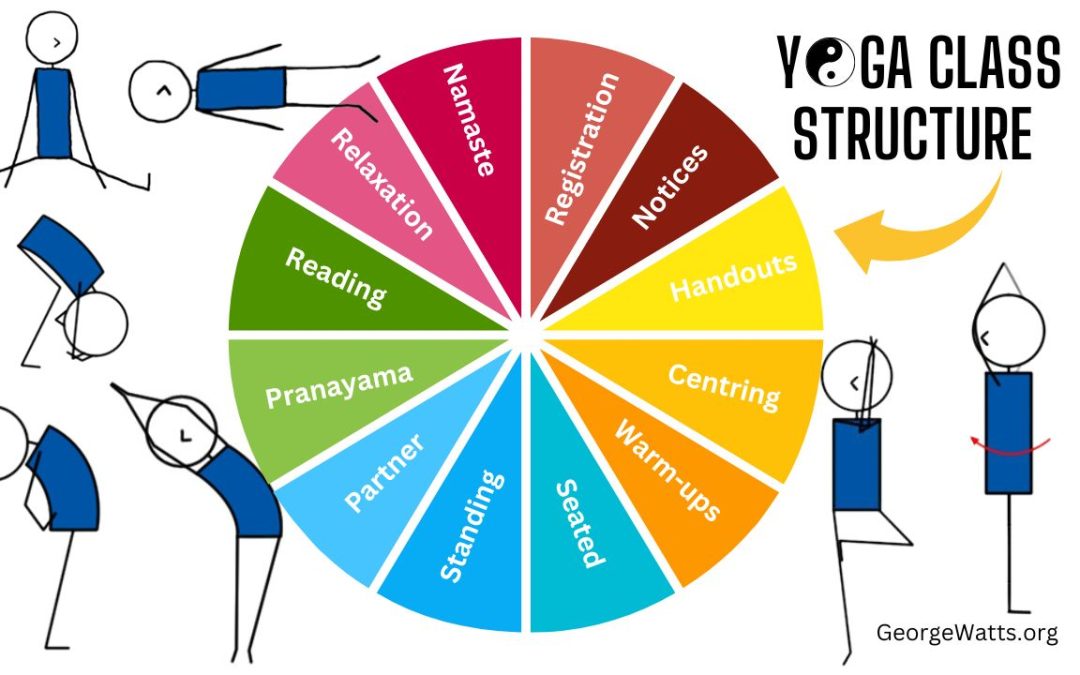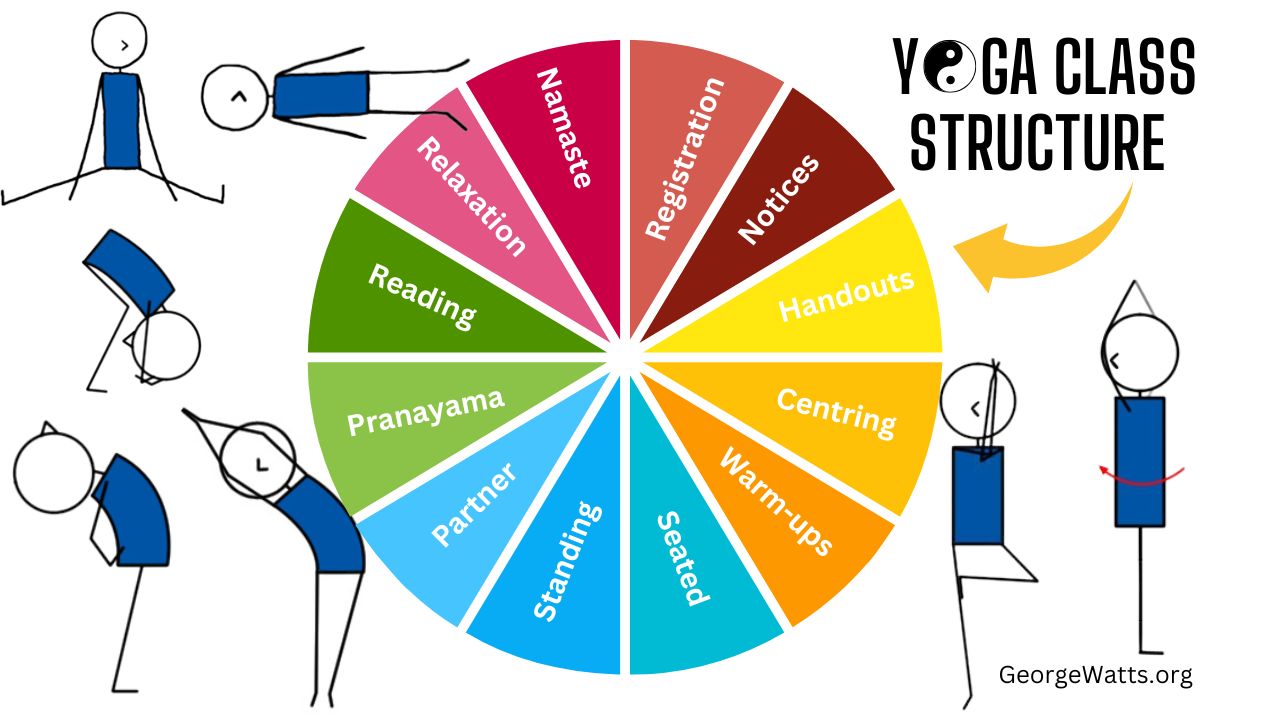My 12-Part Yoga Class Structure: An Infographic To Use As A Template To Create Your Own Structure

In this post, you’ll discover my 12-part yoga class structure.
My name is George Watts.
I’m a BWY yoga teacher and have taught 800+ classes in the last 15 years.
I hope you’ve been enjoying the hundreds of free yoga class planning tips, ready-to-use yoga class plans, and yoga class handouts on my site. They are resources that I’ve personally used for my own yoga classes.
So, why bother creating a yoga class structure?
Let’s find out…
My Top 3 Reasons For Using A Yoga Class Structure

Here are my top three reasons for structuring my yoga classes the same way every time I teach:
- Saves time when planning your classes
- Reduces the stress of planning
- Allows creativity to flourish (because you’re not wasting time structuring)
Coming up with a structure for a yoga class often makes new yoga teachers want to pull every last strand of hair out. It’s as if the newbie teacher is looking for the holy grail of teaching.
Unfortunately that grail doesn’t exist.
There is no right or wrong way to structure a class.
It’s time to relax.
It’s time to accept.
It’s time to banish the destructive thought of their being a ‘perfect class structure’.
There is no such thing as a perfect class structure.
I have provided my 12-part class structure for you to follow, or use as a guide/template so you can create your own.
My 12-Part Yoga Class Structure
Remember, there’s no right way of structuring a yoga class.
This is just a guide for you to edit and come up with your own. For example, you may only have 5-parts to your “yoga class structure”. You don’t have to stick to the formula, and it can evolve over time.
- Registration – Students sign in
- Notices – Tell students about upcoming yoga days, weekends, etc
- Handouts – Give students handouts
- Centring – Awareness of breath
- Warm up Postures
- Seated Postures
- Standing Postures
- Optional – Partner Work and/or Inversions
- Optional – Pranayama and/or Meditation
- Optional – Reading from the Gita, Sutras, etc
- Relaxation
- Namaste – Everyone says Namaste aloud
But don’t stop there. You’re on a roll. You’ll definitely want to look at my 10-step yoga sequencing formula.
“Below are hundreds of yoga lesson planning tips on my blog…to help enlarge your yoga lesson planning brain.” – George Watts
- 101 Yoga Lesson Planning Ideas
- 101 Ways To Teach Yoga With A Poet’s Heart
- 101 Tantalising Yoga Lesson Plan Title Templates
- The Spiritual Meaning Of Yoga Poses: Asana Symbolism
- 101 Guided Yoga Imagery Phrases For Yoga Teachers
- 101 Perfect Quotes For A Quote Themed Yoga Class
- 18 Yoga Lesson Planning Tips: From An Experienced Yoga Teacher
- 12 Part Yoga Class Structure
- 10 Reasons To Use A Yoga Lesson Plan When Teaching
- My 10-step yoga sequencing formula
- 10 Tips To Motivate Your Students To Start A Home Yoga Practice
- 10 Yoga Lesson Planning Tips From 10 Yoga Teachers
- 9 Quirky DIY Yoga Props To Use In Your Classes
- 7 Yoga Imagery Phrases To Inspire Your Students
- 5 Steps For Teaching Relaxation Techniques
- 4 Quick & Easy Ways To Combine Yogic Breathing & Movement To Your Yoga Sequences
- Become An Olympic Yogi: Use Visualisation To Rehearse Your Yoga Classes
- Do Your Own Practice Tactic
- Einstein And Om
- Give Your Yoga Lesson Plans A Chill Pill
- How To Create Yoga Class Themes (5 minute video tutorial)
- How To End Your Yoga Class On Time Every Time
- How To Make A DIY Bolster In 60 Seconds
- How To Sequence Around A Peak Pose: Secret Formula Revealed
- How To Teach Mula Bandha
- How To Write Compelling Yoga Lesson Plan Aims & Objectives
- Include 10 Minutes Of Inversions At The End Of A Class
- Smooth Flowing Yoga Sequence: A Simple Formula For Yoga Teachers
- Yoga Class Plans Made Easy
- Yoga Practice Tracker
- Yoga Sequence Flow Formula
- How I Applied The 8 Limbs Of Yoga To Go From 5 To 25 Students
- How To Become A Full Time Yoga Teacher
- How To Draw Staff Pose
- How To Hire A Local Photographer To Morph You Into A Yoga Star
- How To Remember Student Names
- How To Teach Extended Triangle Pose
- How To Teach Revolved Triangle Pose
- Yoga Anatomy 101: A Crash Course For Yoga Teachers
- Yoga Teacher Poet: How To Teach Backbends With A Poet’s Heart
- Yoga Teacher Poet: How To Teach Boat Pose With A Poet’s Heart
- Yoga Teacher Poet: How To Teach Bow Pose With A Poet’s Heart
- Yoga Teacher Poet: How To Teach Bridge Pose With A Poet’s Heart
- Yoga Teacher Poet: How To Teach Extended Side Angle Pose With A Poet’s Heart
- Yoga Teacher Poet: How To Teach Mountain Pose With A Poet’s Heart
- Yoga Teacher Poet: How To Teach Staff Pose With A Poet’s Heart
- Yoga Teacher Poet: How To Teach Tree Pose With A Poet’s Heart
- Yoga Therapy Precautions Cheat Sheet
Phew. It’s time for my conclusion.
George’s Conclusion: Using Yoga Card Decks As Fun, Easy-to-Use Teaching Aids

I hope you’ve been inspired to create your own yoga class structure.
If you’re a fellow yoga teacher, I’ve got a hunch you’re gonna love my Online Yoga Lesson Planner.
As a Yoga teacher, I’m always looking for fun, easy-to-use teaching aids to make your classes engaging, informative, and effective. That’s why I create yoga card decks. Each deck has been painstakingly crafted to serve as a quick-reference guide, teaching aid, or lesson-planning tool, designed with Yoga teachers, and serious students, in mind.
Chakra Chair Yoga Card Deck: 52 Cards For Mind-Body Unity
The Chakra Chair Yoga Card Deck is a transformative tool designed for yogis of all levels, especially those seeking a gentle, accessible practice. This beautifully illustrated 52-card deck combines the wisdom of the chakra system with the ease of chair yoga, offering a unique way to balance your energy centres while staying grounded and supported.
Chakra Chair Yoga Expansion Card Deck: 52 More Cards For Mind-Body Unity
The Chakra Chair Yoga Card Deck was so popular that I created the Chakra Chair Yoga Expansion Deck with another 52 chair yoga exercises.
Blissful Breathing Card Deck: Your Guide To Mastering Pranayama
The Blissful Breathing Card Deck is your go-to resource for mastering the art of pranayama (yogic breathing). With 41 beautifully designed cards, this Blissful Breathing Card Deck guides you through a wide variety of breathing techniques to enhance relaxation, focus, and vitality.
Face Yoga Card Deck: 50 Cards For Youthful Radiance
The Face Yoga Card Deck is a fun and effective way to tone, relax, and rejuvenate your facial muscles. This 50-card deck features simple, step-by-step exercises designed to improve circulation, boost skin elasticity, and promote a radiant, youthful glow.
101 Mini Yoga Cards: With 101 Asana Sanskrit Pronunciations
The 101 Mini Yoga Cards are a compact and versatile resource for yoga teachers and practitioners alike. Each card features an illustrated yoga pose, its English and Sanskrit names, and how to pronounce the Sanskrit name. This makes it easy to plan classes, create sequences, or inspire personal practice while deepening your connection to yoga’s roots.
Zen Of Blissful Boredom Card Deck: 52 Ways To Cultivate Calm
The Zen Of Blissful Boredom Card Deck offers a lighthearted yet profound approach to finding peace in the mundane. Featuring 52 cards filled with simple, humorous, and mindful activities, this deck encourages you to embrace boredom as a gateway to inner calm and creativity.










